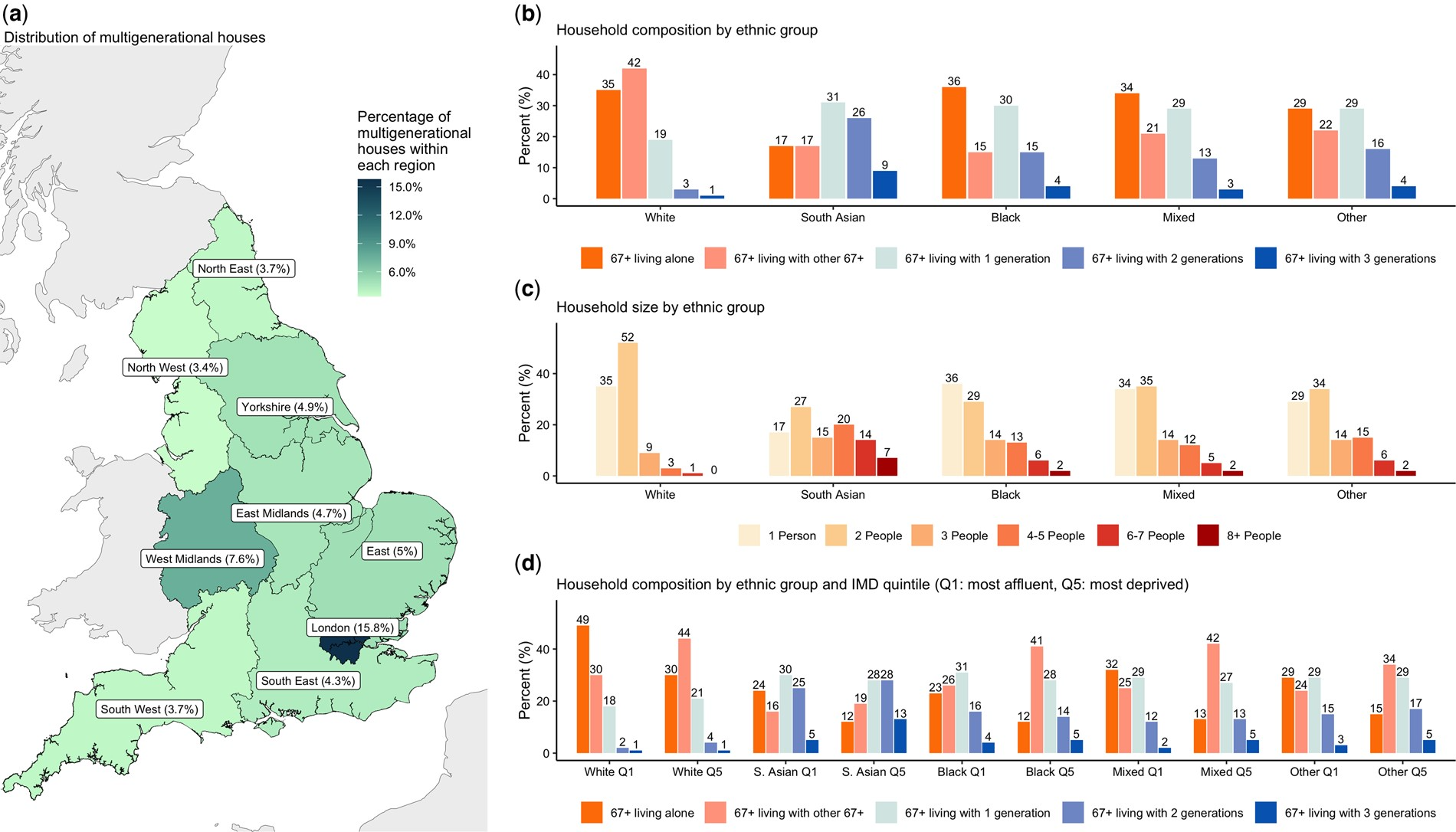Authors: Kevin Wing, Daniel J Grint, Rohini Mathur, Hamish P Gibbs, George Hickman, Emily Nightingale, Anna Schultze, Harriet Forbes, Vahé Nafilyan, Krishnan Bhaskaran, Elizabeth Williamson, Thomas House, Lorenzo Pellis, Emily Herrett, Nileesa Gautam, Helen J Curtis, Christopher T Rentsch, Angel Y S Wong, Brian MacKenna, Amir Mehrkar, Seb Bacon, Ian J Douglas, Stephen J W Evans, Laurie Tomlinson, Ben Goldacre, Rosalind M Eggo, on behalf of the OpenSAFELY consortium
Published: December, 2022 in the International Journal of Epidemiology

Abstract
Ethnic differences in the risk of severe COVID-19 may be linked to household composition. We quantified the association between household composition and risk of severe COVID-19 by ethnicity for older individuals.With the approval of NHS England, we analysed ethnic differences in the association between household composition and severe COVID-19 in people aged 67 or over in England. We defined households by number of age-based generations living together, and used multivariable Cox regression stratified by location and wave of the pandemic and accounted for age, sex, comorbidities, smoking, obesity, housing density and deprivation. We included 2 692 223 people over 67 years in Wave 1 (1 February 2020–31 August 2020) and 2 731 427 in Wave 2 (1 September 2020–31 January 2021).Multigenerational living was associated with increased risk of severe COVID-19 for White and South Asian older people in both waves [e.g. Wave 2, 67+ living with three other generations vs 67+-year-olds only: White hazard ratio (HR) 1.61 95% CI 1.38–1.87, South Asian HR 1.76 95% CI 1.48–2.10], with a trend for increased risks of severe COVID-19 with increasing generations in Wave 2. There was also an increased risk of severe COVID-19 in Wave 1 associated with living alone for White (HR 1.35 95% CI 1.30–1.41), South Asian (HR 1.47 95% CI 1.18–1.84) and Other (HR 1.72 95% CI 0.99–2.97) ethnicities, an effect that persisted for White older people in Wave 2.Both multigenerational living and living alone were associated with severe COVID-19 in older adults. Older South Asian people are over-represented within multigenerational households in England, especially in the most deprived settings, whereas a substantial proportion of White older people live alone. The number of generations in a household, number of occupants, ethnicity and deprivation status are important considerations in the continued roll-out of COVID-19 vaccination and targeting of interventions for future pandemics.
Cite
@article{wing_association_2022,
title = {Association between household composition and severe {COVID}-19 outcomes in older people by ethnicity: an observational cohort study using the {OpenSAFELY} platform},
volume = {51},
issn = {0300-5771},
url = {https://doi.org/10.1093/ije/dyac158},
doi = {10.1093/ije/dyac158},
shorttitle = {Association between household composition and severe {COVID}-19 outcomes in older people by ethnicity},
abstract = {Ethnic differences in the risk of severe {COVID}-19 may be linked to household composition. We quantified the association between household composition and risk of severe {COVID}-19 by ethnicity for older individuals.With the approval of {NHS} England, we analysed ethnic differences in the association between household composition and severe {COVID}-19 in people aged 67 or over in England. We defined households by number of age-based generations living together, and used multivariable Cox regression stratified by location and wave of the pandemic and accounted for age, sex, comorbidities, smoking, obesity, housing density and deprivation. We included 2 692 223 people over 67 years in Wave 1 (1 February 2020–31 August 2020) and 2 731 427 in Wave 2 (1 September 2020–31 January 2021).Multigenerational living was associated with increased risk of severe {COVID}-19 for White and South Asian older people in both waves [e.g. Wave 2, 67+ living with three other generations vs 67+-year-olds only: White hazard ratio ({HR}) 1.61 95\% {CI} 1.38–1.87, South Asian {HR} 1.76 95\% {CI} 1.48–2.10], with a trend for increased risks of severe {COVID}-19 with increasing generations in Wave 2. There was also an increased risk of severe {COVID}-19 in Wave 1 associated with living alone for White ({HR} 1.35 95\% {CI} 1.30–1.41), South Asian ({HR} 1.47 95\% {CI} 1.18–1.84) and Other ({HR} 1.72 95\% {CI} 0.99–2.97) ethnicities, an effect that persisted for White older people in Wave 2.Both multigenerational living and living alone were associated with severe {COVID}-19 in older adults. Older South Asian people are over-represented within multigenerational households in England, especially in the most deprived settings, whereas a substantial proportion of White older people live alone. The number of generations in a household, number of occupants, ethnicity and deprivation status are important considerations in the continued roll-out of {COVID}-19 vaccination and targeting of interventions for future pandemics.},
pages = {1745--1760},
number = {6},
journaltitle = {International Journal of Epidemiology},
shortjournal = {International Journal of Epidemiology},
author = {Wing, Kevin and Grint, Daniel J and Mathur, Rohini and Gibbs, Hamish P and Hickman, George and Nightingale, Emily and Schultze, Anna and Forbes, Harriet and Nafilyan, Vahé and Bhaskaran, Krishnan and Williamson, Elizabeth and House, Thomas and Pellis, Lorenzo and Herrett, Emily and Gautam, Nileesa and Curtis, Helen J and Rentsch, Christopher T and Wong, Angel Y S and MacKenna, Brian and Mehrkar, Amir and Bacon, Seb and Douglas, Ian J and Evans, Stephen J W and Tomlinson, Laurie and Goldacre, Ben and Eggo, Rosalind M and {on behalf of the OpenSAFELY consortium}},
urldate = {2023-09-01},
date = {2022-12-01},
file = {Full Text PDF:/Users/hamishgibbs/Zotero/storage/CZS49GGH/Wing et al. - 2022 - Association between household composition and seve.pdf:application/pdf;Snapshot:/Users/hamishgibbs/Zotero/storage/MDPSFHIY/6665821.html:text/html},
}